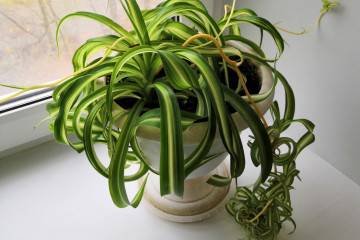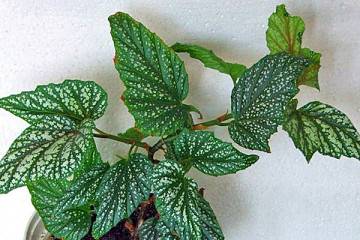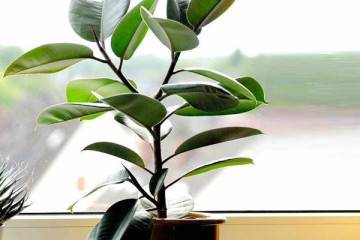Chlorophytum Crested - description and care at home
Content:
It is rare to find a living space that does not contain chlorophytum. Florists love him for its beauty, unpretentiousness, adaptability to any conditions of detention. Next, information will be given on caring for chlorophytum crested at home, as well as possible problems in its cultivation.
What does it look like, which family it belongs to
Chlorophytum crested is a herbaceous perennial plant with green lanceolate leaves, belonging to the Asparagus family. A white, yellow or cream stripe runs along their center or edges.
The leaf plates are collected in bunches, falling like a fountain from the pot. In the spring, small white flowers appear, from which young plants are subsequently formed. When they are a little older, they can be cut and planted in separate containers.
Common varieties
Breeders have bred many varieties of chlorophytum crested, the most popular are the following:
- Vittatum. The leaves of this plant are colored deep green. There is a light stripe in the middle of the leaf plates.
- Variegata. It is a plant with light green leaves, the edges of which are silvered.
- Atlantic. Chlorophytum of this variety is distinguished by delicate, slightly curly leaves.
- Ocean. The leaf plates of the plants are shorter than those of other varieties. Their edges are white.
Healing properties
Chlorophytum has the following beneficial properties:
- absorbs toxic substances;
- humidifies the air in the room;
- destroys pathogenic microorganisms;
- used for wound healing;
- fights negative energy in the house.
History of appearance
Chlorophytum Comosum is native to South America. Under natural conditions, it lives on the roots of trees. It was brought to Europe in the 19th century, where it quickly became popular due to its unpretentious care, beauty, and useful properties.
Chlorophytum enjoyed particular love in the 20th century: it was used to plant trees in schools, hospitals, and kindergartens.
Features of caring for a flower at home
Although chlorophytum is crested and unpretentious, nevertheless, in order for it to manifest itself in all its glory, the plant must be provided with the necessary conditions. If the plantation likes the care, it will serve as a decoration for the room for a long time.
Temperature
The flower tolerates a wide range of temperatures. In summer, it will feel most comfortable at 23-25 ° C. In winter, the optimum temperature of the room in which the plant is located is 18-20 ° C, but it can withstand a decrease without loss of decorativeness up to 8 ° C.
Lighting
Many growers are interested in whether chlorophytum loves the sun. The flower grows best in diffused light. From direct sunlight, leaf plates can be burned.
The more light stripes on the leaves, the more light the flower needs: with a lack of light, the leaf plates become dim.
Watering
Chlorophytum crested will calmly endure a short-term drought. But still it is better to water it on time, and then the leaf plates will always be juicy and bright. In summer, the flower is watered once every 2-3 days, in winter - once every 7 days. It is necessary to ensure that the top layer of soil has time to dry out.
Spraying
Periodically, chlorophytum can be sprayed with water from a spray bottle, and even give the plant a shower. This is especially necessary for flowers that are taken out in the open air for the summer: in these conditions, the leaves quickly become covered with dust, as a result of which the planting becomes difficult to breathe.
Humidity
In winter, the indoor air is dry, so the bushes need help. To increase the humidity, chlorophytum can be placed in a tray, into which small stones are poured and water is poured to the base of the pot. In addition, in winter, a wet rag should be periodically placed on the radiator.
Priming
The culture does not require a special soil composition. The main thing is that it is breathable and permeable. The substrate can be purchased at flower shops, or you can prepare it yourself by mixing sod and leafy soil, humus, sand.
Top dressing
Starting in spring, the flower is watered with a complex mineral fertilizer. Especially feeding is needed during the period of building up children. Chlorophytum is fertilized once every 10-14 days until mid-autumn. Before applying top dressing, the ground is watered with plain water, otherwise the root system may suffer.
Features of winter care
In winter, crested chlorophytum is dormant. This means that its growth, flowering, growth of children stops.
Therefore, in winter, watering and feeding the flower decreases. During this period, it is enough to feed the plant once a month in 2 times less dose than in summer.
When and how it blooms
At the beginning of summer, white small inflorescences appear on chlorophytum. Provided that the plant is kept in a warm, well-lit place, flowering can occur at other times of the year. For the appearance of a large number of flowers, fertilizing and timely watering are also necessary.
Plantings begin to bloom at the age of one or one and a half years. Full flowering begins only after the root system has fully mastered the pot. Therefore, chlorophytum cannot be planted directly into a large container.
Pruning
Chlorophytum has the ability to grow in the form of a rosette, and therefore does not require special pruning. You can only periodically cut off layers with young plants if flower reproduction is required. Since babies take away a lot of strength from the mother plant, they are also removed when the immunity of chlorophytum is reduced.
How chlorophytum multiplies
You can propagate a culture at home in several ways: by dividing a bush, air sockets, seeds.
Dividing the bush
An adult plant propagates in this way. When the bush becomes thickened, it loses its decorative effect. This is due to the fact that the plantation begins to lack food area.
Therefore, adult plants are divided into several parts and transplanted into separate containers. Each section should have roots and several leaves.
Reproduction by rosettes
Chlorophytum builds up arrows, at the ends of which flowers are first formed, then small rosettes. When young plants grow up, they are treated as follows:
- cut with a knife, put in a glass of water for rooting;
- when small roots appear, the outlets are planted in separate containers with loose, fertile soil;
- watered, put containers in a bright, but shaded place at noon.
The rosettes can be cut and planted immediately in separate pots. Another way to reproduce with rosettes is to plant them in separate containers without separating them from the mother plant. When the plants grow up, cut them off from the arrows.
Seeds
Chlorophytum can be propagated by seed. To do this, purchase seed material in a flower shop, soak it for a day in water with the addition of a growth enhancer. Then the seeds are planted in a box of fertile soil.
When shoots appear, they are transplanted into small containers. As they grow older, the bushes are transferred into larger pots.
Transfer
After purchasing chlorophytum in a flower shop, it is placed in a dark, cool place for 2 weeks. So the flower quickly adapts to new conditions of detention. Then it is transplanted into a pot, which is 2-3 centimeters larger than the previous one.
If you choose a large container at once, the ground part of the bush will not develop until the root system braids the entire container. In the future, matured bushes are transplanted as needed.
Possible growing problems and diseases
Chlorophytum is an unpretentious flower, but even it can lose its decorative effect in case of mistakes in care.
Casting pale
This happens if the plant is planted in the back of the room, away from sunlight. To fix the problem, the flower must be transferred to a bright place, protected from direct sunlight.
The tips of the leaves dry
Most often this happens due to an excess of moisture and a large amount of applied fertilizers. To restore the decorative effect of the flower, it is transplanted into another land, moderately watered and fed.
The lower leaves dry up
This is a natural process. The lower leaves of mature plants gradually turn yellow and dry out. They need to be carefully cut, and then they will not spoil the appearance of the plantings.
Pests
Chlorophytum can be attacked by aphids, scale insects, spider mites. This happens very rarely: only a very weakened plant is affected by pests. Insects can be washed off with soapy water. If this procedure does not help, any insecticide is used.
Signs and superstitions
Chlorophytum is characterized only on the positive side. For example, so that new settlers can quickly get used to the new territory, they are encouraged to enter the house with a flower in their hands.
According to popular beliefs, if lonely people keep chlorophytum in the house, they will certainly find a mate.
Crested chlorophytum is one of the most unpretentious indoor plants. It requires a minimum of care. Even if the florist for some reason could not take care of the planting for several days, it will not disappear, and will quickly restore its former decorative appearance.





















